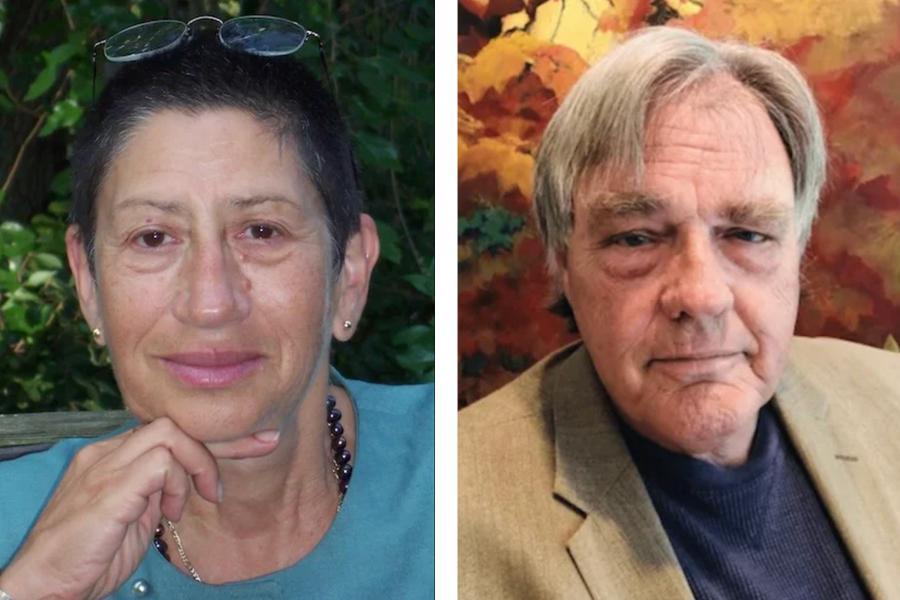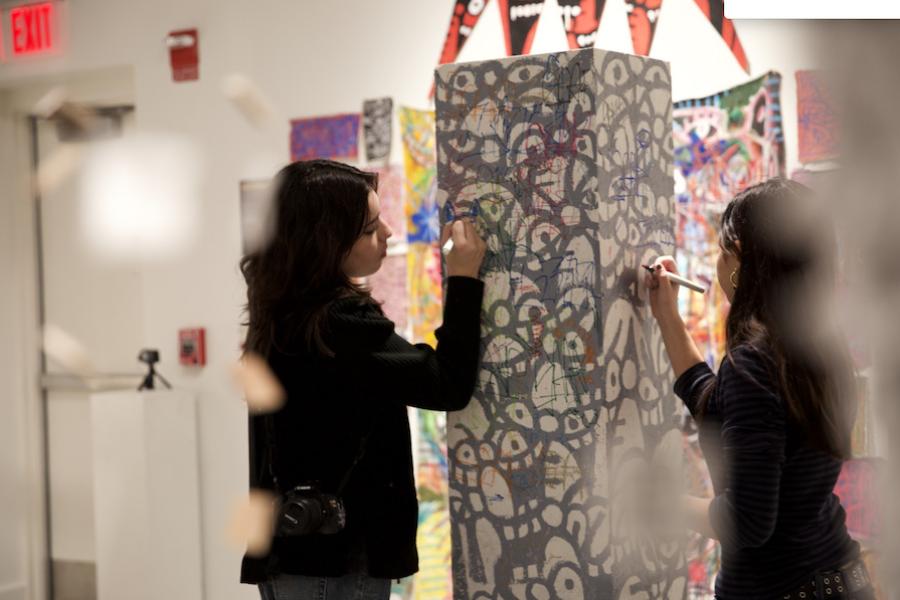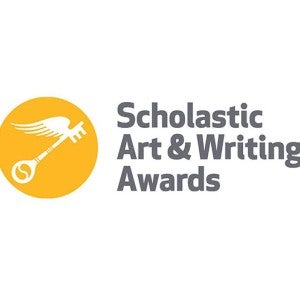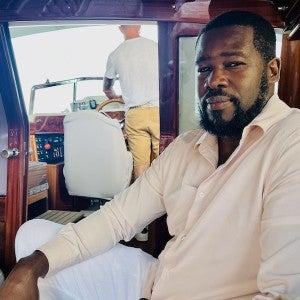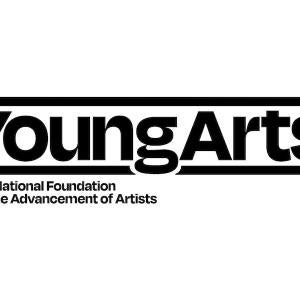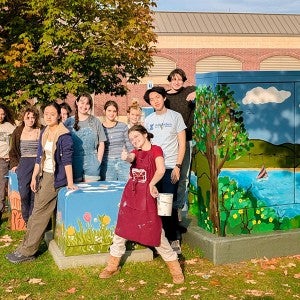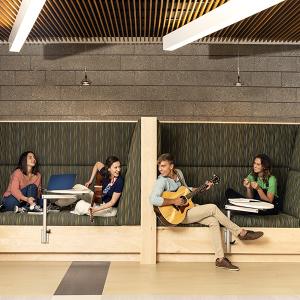This art show is for you: How two museum consultants are changing the way Interlochen students think about accessibility
Elaine Heumann Gurian and James Volkert have dedicated their careers to making sure everyone feels welcome at museums. Now, they’re training the next generation of visual artists to create spaces where individuals with disabilities can learn and thrive.

It’s a Friday in early October, and the Dow Visual Arts Center sparkles with activity and commotion. Students are putting the finishing touches on art installations in the gallery. On first glance, this might look like a typical senior exhibition at any arts school. But there’s actually a lot more going on here. Tomorrow, the exhibit will open in an exclusive preview that welcomes a very special crowd: students from Disability Network Northern Michigan, Down Syndrome Association of Northern Michigan, Arts for All of Northern Michigan, and more.
At Interlochen, the Visual Arts thesis is a chance for seniors to show off new techniques and define their style as they prepare to apply to colleges. It’s also the culmination of a fast-paced week in which these high school students learn to craft an entire exhibition with an eye to radical inclusion. Which populations are most marginalized by arts museums? Which populations struggle with sensory stimuli, mobility, or other challenging aspects of a typical exhibition? At Interlochen, these populations aren’t an afterthought. They’re the main audience.
For the past eight years, Interlochen has brought in renowned museum consultant Elaine Heumann Gurian to teach and advise students as they prepare the senior exhibition. This year, Gurian is joined by fellow artist and museum consultant James Volkert. The two of them draw from decades of museum experience at the Smithsonian and beyond as they encourage the next generation of artists to engage their audience in powerful ways. The future of museum accessibility is right here at Interlochen.
Pointing out a major problem in the museum world—and proposing a solution
Gurian started out as an elementary art school teacher, then worked her way into a position at the Boston Children’s Museum in 1970. It was the start of a decades-long career in the museum business, which included roles as deputy assistant secretary for the Smithsonian museums, deputy director for the National Museum of the American Indian, first head of the National Museum of African American History and Culture, and deputy director of the Holocaust Museum.
She first met James Volkert in the 1980s, when both of them were getting involved in the new frontier of children’s museums. Volkert has also built a thriving career in the museum industry. He spent 20 years at the Smithsonian Institution, was associate director of the National Museum of the American Indian, and taught exhibition development at the George Washington University for 10 years. Recently, he’s rediscovered his own artistic gifts, and his collections have been showcased at Historic Arkansas Museum, Grand Valley State University Museum, and South Bend Museum of Art.
Gurian and Volkert soon found they shared a common vision for the future of art museums. In their conversations, they identified and articulated what they saw as a major problem in the museum world.
Deep in the training of visual artists and the presentation of their art in art museums was the notion that 'if you don't understand, too bad for you.'
“Deep in the training of visual artists and the presentation of their art in art museums was the notion that if you don't understand, too bad for you,” says Gurian. “If you like art and you understand art, you come to art museums. But if you don't know anything about art, and when you get there you're flummoxed, it’s ‘not the art museum's problem.’ It was an intentional elitism, structural and systemic.”
“We were both very intent on figuring out: how could exhibitions be more engaging, more participatory?” adds Volkert. “At that time, there was nothing like that anywhere on the landscape. There was no visitor engagement in more mainline museums.”
In their search for a new perspective, Gurian and Volkert looked to other types of museums that took their obligations to their audiences more seriously. Zoos, history museums, cultural museums, and children's museums provided inspiration and key examples of how to effectively engage museum visitors. The two began collaborating on numerous projects, working in museums as far-flung as Ukraine and Argentina.
“Elaine’s Week”
Almost a decade ago, Gurian found herself at Interlochen with her husband, Dean Anderson, who is an Arts Camp alumnus and a former member of Interlochen’s Board of Trustees. As they explored campus and met students from around the world, Gurian was struck with an idea: what if she could reach a whole generation of young artists with her vision?
She imagined a special intensive completely focused on creating accessible exhibits: “I’ll do it by teaching them installation techniques. They will have to make an interactive that explains their work to the visitors. And we'll do it in five days’ time, which is crazy.”
Gurian posed her plan to Mindy Ronayne, Director of Visual Arts at Interlochen. Ronayne responded enthusiastically, and an Interlochen tradition was born.
“It’s considered the hardest week of the year,” Gurian says. “Last year, they had a little ceremony and gave me a shirt. It says, ‘I survived Elaine’s Week’!”
All components in the exhibition—whether it's what you read or some physical interactives—need to be accessible to the widest possible audience.
Answering elitism by keeping the family in mind
Gurian and Volkert use “Elaine’s Week” as an opportunity to respond to elitism in the visual arts world by building an exhibit that everyone can enjoy. Volkert likes to think of it in terms of the multigenerational family.
“The exhibition is designed for families. If you begin breaking that down, the word ‘family’ could mean a lot of things, not just the nuclear family or the archetypal family. All components in the exhibition—whether it's what you read or some physical interactives—need to be accessible to the widest possible audience. How can you begin thinking about all of that in the context, so that the exhibition itself is rewarding for anyone along that spectrum?”
For Gurian, accessibility is a personal issue: “I had a severely handicapped child, and I’m hearing impaired. So this has always mattered to me.”
She challenges Interlochen students to go outside their comfort zones and come up with inventive solutions.
“The students are surprised when I say things like, ‘That's very nice, but people who are blind are going to trip over it, so you can't do that. What's your plan?’ That sentence has never been said to them before,” she says. “And then they work creatively on what they're going to do about that.”
An ongoing impact
Gurian has been coming to Interlochen for eight years now, so you don’t have to look far to see the impact she has on her students.
“Their art practice changes almost immediately,” she says. “We have graduates who write back and tell us how their practice has changed, including one who did an installation at the Grand Rapids Art Museum about accessibility based on work that she’d done in her senior year.”
Gurian is referring to Oaklee Thiele, whose outdoor exhibition My Dearest Friends earned her recognition as the ArtPrize Featured Artist of 2021.
For his part, Volkert takes pride in seeing how the students develop professionalism over the course of the week.
“Elaine and I have worked with hundreds of exhibitions, so the process that we go through with our students is very much the process that any museum goes through in developing and installing an exhibition,” he says. He notes that the week also provides graduating seniors with valuable components for their portfolios. “For these students, it's a significant leap into the real world of museums and exhibitions.”
Interlochen has a uniquely powerful focus on externalizing both your art and your responsibility to others.
“The instant of connection”
At the heart of what Volkert and Gurian are doing is—quite simply—that one special moment that defines what museums are designed to do.
“For me, it’s all about that instant of connection between the viewer and the object in the exhibition,” says Volkert. “You hope that because of all your planning, something happens in that moment, and the viewer goes, ‘Oh, that’s cool,’ or ‘Oh, I get that,’ or ‘Oh, that reminds me of…’”
Gurian and Volkert want these moments to be accessible for everyone, regardless of age, background, ability, or any number of factors. Interlochen is the perfect place for them to share this vision of inclusion.
“Interlochen has a uniquely powerful focus on externalizing both your art and your responsibility to others,” says Gurian. “The first year that we did it, the students named the show ‘This Art Show Is For You.’ That's why I do this.”
Learn more about Interlochen Arts Academy, the Visual Arts major, or accessibility at Interlochen.
